Many not Getting Enough Nutrients in Their Pregnancy, Study Finds

It’s generally estimated that around 10% of pregnant people struggle to meet their nutritional needs – but the real number could be far higher, according to new research in The Journal of Nutrition.
Over 90% of pregnant individuals are potentially failing to get enough iron, vitamin D, or vitamin E from the food they eat, while over one-third could be short of calcium, vitamin C, and vitamin A. Troublingly, almost two-thirds of pregnant people were also found to be getting insufficient dietary folate – a critical nutrient that helps prevent birth defects in the baby’s brain and spine.
“It’s important to remember that many pregnant people take prenatal vitamin supplements, which might help prevent nutritional deficiencies,” says lead author Dr Samantha Kleinberg, professor at Stevens Institute of Technology. “Nonetheless, this is a startling finding that suggests we need to be looking much more closely at whether pregnant individuals are getting the nutrients they need.”
Where most previous studies of nutrition during pregnancy relied on a few days of food diaries, or on simply asking people what they remembered eating, the Stevens team asked pregnant people to take before-and-after photos of everything they ate over two 14-day periods. Experts then reviewed the photos to assess the amount of food actually eaten and determine the nutrients consumed during each meal.
That’s a far more accurate approach, because people are notoriously bad at estimating portion size or accurately reporting what they’ve eaten, Dr Kleinberg explains. A photo-based approach is also much less laborious for pregnant people, making it easy to collect data over a period of weeks instead of just a few days.
“Most surveys only track diet over a day or two – but if you feel off one day and don’t eat much, or have a big celebratory meal over the weekend, that can skew the data,” Dr Kleinberg says. “By looking at a longer time period, and using photos to track diet and nutrition, we’re able to get a much richer and more precise picture of what people actually ate.”
The study found significant dietary variations between individuals, but also among the same individuals from one day to the next, suggesting that shorter studies and population-based reports might be failing to spot important nutritional deficits. “Some people eat really well, and others don’t – so if you just take an average, it looks like everything’s fine,” Dr Kleinberg explains. “This study suggests that in reality, an alarming number of pregnant people may not be getting the nutrients they need from their food.”
Using food photos also recorded the exact timing of meals and snacks, and to explore the way that patterns of eating behaviour correlated with total energy and nutrient intake. When pregnant people ate later in the day, the data shows, they were likely to consume significantly more total calories – potentially an important finding as researchers explore connections between eating behaviours and health problems such as gestational diabetes.
The current research didn’t directly study health outcomes, so it’s too early to say whether insufficient nutrition or excessive energy consumption is adversely impacting pregnant individuals or their babies. “We’ll be digging into that in future studies, and looking at possible connections with eating patterns and changes in glucose tolerance,” Dr Kleinberg says.
Source: Stevens Institute of Technology









